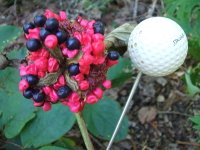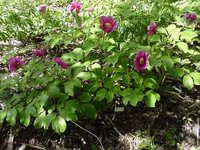 Paeonia tenuifolia, the Fernleaf Peony, has opened in full sun. The dwarf subspecies in a bed which is a bit shaded in the mornings is not open yet. There are 2 plants in this photo; on the left, a dark red proper species; on the right, the larger plant is probably a hybrid (it has yet to set seed) and has flowers with a more magenta tint.
Paeonia tenuifolia, the Fernleaf Peony, has opened in full sun. The dwarf subspecies in a bed which is a bit shaded in the mornings is not open yet. There are 2 plants in this photo; on the left, a dark red proper species; on the right, the larger plant is probably a hybrid (it has yet to set seed) and has flowers with a more magenta tint. Paeonia steveniana, Steven's Peony if one must put a common name to it, as open as it will get. A cloudy day today, so the colour is intensified; it is never that intense of a yellow here.
Paeonia steveniana, Steven's Peony if one must put a common name to it, as open as it will get. A cloudy day today, so the colour is intensified; it is never that intense of a yellow here. And here it is behind a crowd of Paeonia mascula and some Paeonia caucasica (a subsp of mascula and pretty much identical to my eye.
And here it is behind a crowd of Paeonia mascula and some Paeonia caucasica (a subsp of mascula and pretty much identical to my eye. A few more buds of steveniana, behind a few plants of another mascula close relative, Paeonia kesrouanensis. (More information about this plant, or any other, by looking up earlier posts in the index.)
A few more buds of steveniana, behind a few plants of another mascula close relative, Paeonia kesrouanensis. (More information about this plant, or any other, by looking up earlier posts in the index.) And unexpectedly, a plant of the Golden Peony, Paeonia mlokosewitschii, a couple of days earlier than expected. And filling the yard with it's fragrance at an intensity I've never noticed before.
And unexpectedly, a plant of the Golden Peony, Paeonia mlokosewitschii, a couple of days earlier than expected. And filling the yard with it's fragrance at an intensity I've never noticed before.Good news for customers, there are about 15 potted plants from seed of this species in bud (will probably open sometime in the next week)-- not all will be yellow-flowered which is why I have to see the flowers before I can sell the plants- at least one looks like it will be magenta (mascula cross), and some may be apricot or very pale yellow, almost white. Can;t wait to see it (but have to!!)
































